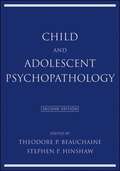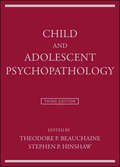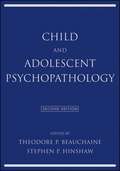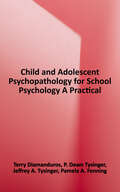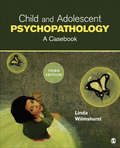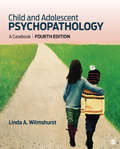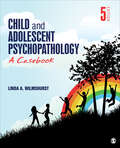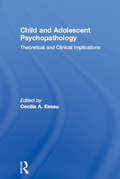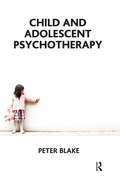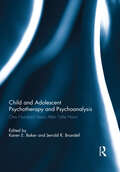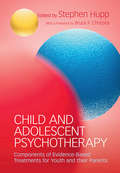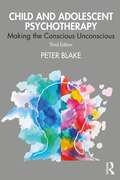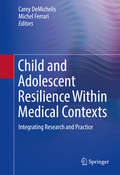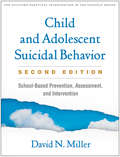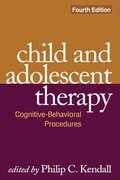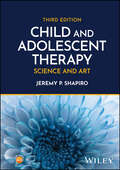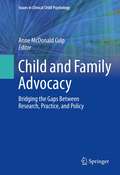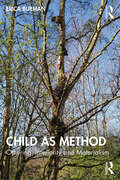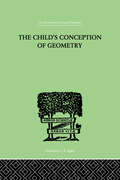- Table View
- List View
Child and Adolescent Psychopathology
by Theodore P. Beauchaine Stephen P. HinshawChild and Adolescent Psychopathology, Second Edition is the only comprehensive text on childhood and adolescent disorders that addresses genetic, neurobiological, and environmental factors within a developmental perspective. The new edition includes more on epigenetics, classification, culture and context and emphasizes how, when, and why disorders emerge among young people and in what ways symptom profiles change at different stages of development.
Child and Adolescent Psychopathology
by Theodore P. Beauchaine Stephen P. HinshawA unique, multi-discipline, developmental approach to childhood psychopathology Child and Adolescent Psychopathology is the only comprehensive text in the field to address genetic, neurobiological, and environmental factors within a developmental context. Based on cutting-edge research and aligned with the DSM-5, this book emphasizes how, when, and why disorders emerge among young people, and the ways in which symptom profiles change at different stages of development. This new third edition has been updated to include new chapters on OCD and trauma disorders consistent with DSM-5 classification, and includes new discussion on epigenetics and the neighborhood effects on the development of delinquency. Coverage includes extensive discussion of risk factors, from disturbed attachment relations and abuse/neglect, to head injury and teratogen exposure, followed by in-depth examination of behavior disorders and psychological disorders including Autism Spectrum, Schizophrenia Spectrum, and Eating Disorders. Psychological disorders in children are increasingly being explored from a relational perspective, and continuous advances in neurobiology research are adding an additional dimension to our understanding of cause, effect, and appropriate intervention. This book provides detailed guidance toward all aspects of childhood psychopathology, with a multi-discipline approach and a unique developmental emphasis. Discover how psychopathology emerges throughout the stages of development Learn how both genetics and environmental factors influence risk and behaviors Understand the prevalence, risk factors, and progression of each disorder Gain deep insight from leading experts in neurobiology and developmental psychopathology As the field of child psychology continues to evolve, behavioral and psychological disorders move beyond a list of symptoms to encompass the 'whole child'—biology, chemistry, environment, and culture are becoming increasingly relevant in understanding and treating these disorders, and must be considered from the earliest assessment stages. Child and Adolescent Psychopathology provides comprehensive information on childhood disorders from a developmental perspective.
Child and Adolescent Psychopathology (2nd Edition)
by Theodore P. Beauchaine Stephen P. HinshawChild and Adolescent Psychopathology, Second Edition is the only comprehensive text on childhood and adolescent disorders that addresses genetic, neurobiological, and environmental factors within a developmental perspective. The new edition includes more on epigenetics, classification, culture and context and emphasizes how, when, and why disorders emerge among young people and in what ways symptom profiles change at different stages of development.
Child and Adolescent Psychopathology for School Psychology: A Practical Approach
by Pamela A. Fenning Terry Diamanduros P. Dawn Tysinger Jeffrey A. TysingerThis is the only text to address child and adolescent psychopathology from the viewpoint of the school psychologist. Integrating, comparing, and distinguishing DSM-5 diagnoses from IDEA disability classifications, it provides a comprehensive overview of mental health conditions in this population. This book addresses the impact of these conditions at school and at home, along with a description of practical, evidence-based educational and mental health interventions that can be implemented in school environments. It addresses the role of the school psychologist and details a variety of educational supports and school-based mental health services as they apply to specific conditions. This resource provides comprehensive coverage of school psychologists' responsibilities, including assessment, educational and skill-based interventions and supports, consulting with key stakeholders, and advocacy. Case studies address classification issues and varied approaches psychologists can use to support students. Chapters provide a variety of features to reinforce knowledge, including quick facts, discussion questions, and sources for additional resources. Instructor's ancillaries include an instructor's manual, test questions, and mapping to NASP domains as well as PowerPoints and a test bank. Purchase includes digital access for use on most mobile devices or computers. Key Features: - Provides a school psychological approach to addressing a full gamut of child/adolescent mental health problems at school and at home - Integrates, compares, and distinguishes DSM-5 diagnoses, IDEA disability classifications and other legal protections (i.e., Section 504) for each disorder - Covers the impact of various disorders on a child's ability to learn and function in the classroom - Addresses practical, evidence-based educational supports and school-based mental health services suited to specific disorders - Includes case studies addressing classification issues and delineating practical student supports.
Child and Adolescent Psychopathology: A Casebook
by Dr Linda WilmshurstFully updated for DSM-5, the Third Edition of Child and Adolescent Psychopathology provides 24 real-life cases to equip students with the knowledge, skills, and tools they will need as practicing clinicians. As they explore realistic, complex cases, students learn to integrate theory into research-based assessments and interventions. Each case provides opportunities to practice clinical skills in the assessment, diagnosis, and treatment of childhood disorders from a number of theoretical perspectives and at various levels of interest and expertise. Designed to be used with a child psychopathology text, this practical casebook covers current trends in the field and promotes an understanding of the role of risk and protective factors in assessment and treatment.
Child and Adolescent Psychopathology: A Casebook
by Dr Linda WilmshurstChild and Adolescent Psychopathology: A Casebook by Linda A. Wilmshurst provides 25 real-life cases to give readers a deeper understanding of a wide range of disorders within the context of the DSM–5. As they explore complex cases, readers learn to integrate theory into research-based assessments and interventions. Each case provides opportunities to practice clinical skills in the assessment, diagnosis, and treatment of childhood disorders from a number of theoretical perspectives and at various levels of interest and expertise. Reflecting the latest developments in the field, the Fourth Edition now includes a new case study on social phobia/social anxiety disorder, additional post-case questions, and an expanded introductory chapter discussing trends in case formulation.
Child and Adolescent Psychopathology: A Casebook
by Dr Linda WilmshurstChild and Adolescent Psychopathology: A Casebook by Linda A. Wilmshurst provides 25 real-life cases to give readers a deeper understanding of a wide range of disorders within the context of the DSM–5. As they explore complex cases, readers learn to integrate theory into research-based assessments and interventions. Each case provides opportunities to practice clinical skills in the assessment, diagnosis, and treatment of childhood disorders from a number of theoretical perspectives and at various levels of interest and expertise. Reflecting the latest developments in the field, the Fourth Edition now includes a new case study on social phobia/social anxiety disorder, additional post-case questions, and an expanded introductory chapter discussing trends in case formulation.
Child and Adolescent Psychopathology: A Casebook
by Linda WilmshurstChild and Adolescent Psychopathology: A Casebook, Fifth Edition provides students with an opportunity to gain deeper insight into a wide range of disorders within the context of the diagnostic framework of the DSM-5. This supplemental textbook provides an abundance of "real life" cases which demonstrate methods in assessing and treating a wide spectrum of child and adolescent psychopathologies in a variety of settings. Each case presents an opportunity to practice and develop clinical skills in the assessment, diagnosis, and treatment of childhood disorders from a number of theoretical perspectives and at various levels of interest and expertise. The book features current trends in assessment, diagnosis, treatment, and research. It is an ideal hands-on resource for a child and adolescent psychopathology course. The Fifth Edition includes a new case study on depression, expanded coverage of trauma-related disorders, a new glossary, and updated assessment materials and references throughout.
Child and Adolescent Psychopathology: A Casebook
by Linda WilmshurstChild and Adolescent Psychopathology: A Casebook, Fifth Edition provides students with an opportunity to gain deeper insight into a wide range of disorders within the context of the diagnostic framework of the DSM-5. This supplemental textbook provides an abundance of "real life" cases which demonstrate methods in assessing and treating a wide spectrum of child and adolescent psychopathologies in a variety of settings. Each case presents an opportunity to practice and develop clinical skills in the assessment, diagnosis, and treatment of childhood disorders from a number of theoretical perspectives and at various levels of interest and expertise. The book features current trends in assessment, diagnosis, treatment, and research. It is an ideal hands-on resource for a child and adolescent psychopathology course. The Fifth Edition includes a new case study on depression, expanded coverage of trauma-related disorders, a new glossary, and updated assessment materials and references throughout.
Child and Adolescent Psychopathology: Theoretical and Clinical Implications
by Cecilia A. EssauHow do biological and environmental factors influence the development of childhood and adolescent disorders? There has been a substantial increase of interest in research into child and adolescent psychopathology. In this book, Cecilia Essau brings together contributions from the UK, the US and Canada to provide a comprehensive summary of the information available on the subject. Beginning with an introduction to general issues related to child and adolescent psychopathology, including theoretical models of normal and abnormal development, each chapter goes on to address the issues associated with specific disorders, such as: oppositional defiant disorder and conduct disorder attention-deficit/hyperactivity disorder eating disorders substance use disorders somatoform disorders. The contributors present a thorough overview of each disorder, including discussion of definition and classification, epidemiology, risk factors, comorbidity, course, outcome and prevention. Child & Adolescent Psychopathology will be welcomed by all mental health professionals seeking a reliable source of scientifically and clinically relevant information on the nature and treatment of child and adolescent disorders.
Child and Adolescent Psychotherapy
by Peter BlakeIn this book, Peter Blake articulates his clinical practice of child and adolescent psychotherapy. A clear conceptual framework and historical context is provided for the work. The book is then structured to follow the therapeutic process, from assessment (referral and initial interview, individual assessment, developmental considerations, assessment for therapy, working with parents) to therapy (physical and mental settings, interpretation, the role and challenges of play, transference and countertransference, termination). Drawing on the Winnicottian tradition, in which fun and humour have a place in child and adolescent work, Blake demonstrates how a therapist can be playful and less directly interpretative. How psychodynamic thinking can be applied in an effective yet time-limited manner is also demonstrated. The text is enlivened by many case studies and clinical anecdotes. For therapists who are new to child and adolescent psychotherapy, and who wish to take a psychodynamic approach, the book will provide a valuable introduction.
Child and Adolescent Psychotherapy and Psychoanalysis: One Hundred Years After 'Little Hans'
by Karen E. Baker and Jerrold R. BrandellSince Freud’s publication of 'Little Hans', advances in psychoanalytic technique and theory have transformed our clinical work with children. Individuals including Anna Freud, Melanie Klein and Donald Winnicott have influenced psychoanalytic play therapy and broadened the scope of practice with them. Contemporary psychoanalysts and psychoanalytic social work clinicians often find themselves responding to misapprehensions and distortions about psychoanalytic theory and treatment created or promoted in popular culture. Furthermore, clinical practices are subject to the disruptive influence of managed mental health care and, with the ascendancy of biological psychiatry, an increasing reliance on psychoactive drugs in the treatment of children, often in the absence of sound research support. In this book, expert international contributors explore developmental, theoretical and clinical themes in work with children. Focusing on diverse populations and varied treatment settings, they present compelling clinical cases and research that, collectively, demonstrate the efficacy and relevance of psychoanalytic ideas in the context of play therapy. This book was originally published as a special issue of Psychoanalytic Social Work.
Child and Adolescent Psychotherapy: Components of Evidence-Based Treatments for Youth and their Parents
by Bruce F. Chorpita Stephen HuppEvery day, millions of children experience serious mental health issues such as symptoms related to autism, psychosis, mania, depression, and anxiety. Moreover, many youth struggle with issues related to trauma, eating, sleep, disruptive behavior, and substance use. Most of these youth do not receive evidence-based treatments. Instead, they commonly receive untested, ineffective, and even harmful treatments. Child and Adolescent Psychotherapy presents the research-supported treatment packages and their individual components for every major mental health issue facing infants, children, and adolescents. Each chapter also identifies and analyzes other variables and resources that influence treatment: parents, assessment, comorbidity, demographics and medication. Useful resources are included for each mental health issued covered in the book. The chapters are organized in the same order as they appear in the DSM-5.
Child and Adolescent Psychotherapy: Making the Conscious Unconscious
by Peter BlakeIn this new edition Blake gives a personal account of his professional experience of working with children and adolescents over the last 45 years. Providing a wonderful integration of the conceptual and the practical, this book clarifies complex theory while giving practical advice for clinicians through a nuts and bolts description of how to interview parents, emotionally assess a child and adolescent, set up a consulting room and conduct a therapy session. The addition of chapter summaries, questions and suggested further readings provides a valuable structure to those in child and adolescent training programmes. The author’s experience, gained from public and private work, is vividly described with the use of clinical examples to illustrate his thinking and way of working. This third edition highlights his evolution from a more traditional epistemological (knowing) approach, with its emphasis on interpretation and insight, to a more ontological (being) framework. He explores a more intuitive and unconscious way of working and argues this is more developmentally appropriate to children and adolescents. His accessible writing style transports the reader into his clinical world: a world full of fascinating stories of children talking through their play; of adolescents exploring who they are through their discussions about music, films, sport and computer games; of helping parents to understand and thoughtfully manage their child’s emotional struggles. This new edition, an amalgam of theoretical orientations (Kleinian, Bionian, Winnicottian, relational, non-linear and neurological), draws from recent developments, both in theory and technique. It will be of immense value to psychotherapists, psychoanalysts and all those involved in the treatment of children’s mental health.
Child and Adolescent Resilience Within Medical Contexts: Integrating Research and Practice
by Michel Ferrari Carey DemichelisThis book explores the social conditions that promote pediatric resilience. It presents resilience as a set of complex interpersonal, institutional, and political relationships that affect young patients' ability to "do well" in the face of medical adversity. Chapters analyze the impact of chronic or disabling conditions on children's development, while highlighting effective interventions that promote family well-being. This book integrates research from psychology, social work, medical anthropology, child life specialty, palliative care, public health, and nursing to examine a wide variety of family, cultural, and medical contexts. Practical strategies for supporting children and families are discussed, from meaningful assessment and interventions to social policy and advocacy. Featured topics include: Psychosocial factors influencing children with immune-related health conditions. Resilience and pediatric cancer survivorship within a cultural context. Promoting resilience in chronically ill children and their families during the transition to adolescence. Creating a context for resilience in medical settings. Promoting resilience through children's health and social care policy. Child and Adolescent Resilience Within Medical Contexts is a must-have resource for researchers, clinicians and other professionals, as well as graduate students in child and school psychology, child and adolescent psychiatry, social work, pediatrics, medical anthropology, nursing, educational psychology and policy.
Child and Adolescent Suicidal Behavior, Second Edition: School-Based Prevention, Assessment, and Intervention (The Guilford Practical Intervention in the Schools Series)
by David N. MillerThis comprehensive resource--now revised and expanded--provides school practitioners with an evidence-based framework for preventing and effectively responding to youth suicidal behavior. David N. Miller guides readers to understand, screen, and assess for suicide risk in students in grades K–12. He presents collaborative strategies for intervening appropriately within a multi-tiered system of support. The book also shows how to develop a coordinated plan for postvention in the aftermath of a suicide, offering specific dos and don'ts for supporting students, parents, and school personnel. User-friendly tools include reproducible handouts; the book's large-size format facilitates photocopying. Purchasers get access to a Web page where they can download and print the reproducible materials. New to This Edition *Chapter on the roles and responsibilities of the school-based suicide prevention team. *Significantly revised coverage of screening and suicide risk assessment. *Situates prevention and intervention within a schoolwide multi-tiered system of support. *Updated throughout with current data, practical recommendations, and resources.
Child and Adolescent Therapy
by Robert D. Friedberg Karen K. Bardenstein Jeremy P. ShapiroThis comprehensive guide to child therapy provides a thorough introduction to the principles and practice of psychotherapy with children and adolescents. It provides balanced coverage of child therapy theory, research, and practice. Adopting an integrated approach, the authors bring both the science ofevidence-based practice and the art of therapy into each chapter.
Child and Adolescent Therapy, Fourth Edition
by Philip KendallWidely regarded as the definitive clinical reference and text in the field, this authoritative volume presents effective cognitive-behavioral approaches for treating frequently encountered child and adolescent disorders. The editor and contributors are leading experts who provide hands-on, how-to-do-it descriptions illustrated with clinical examples. Relevant theories and research findings are explained, and exemplary treatment manuals and client workbooks reviewed. Coverage encompasses evidence-based treatments for aggression, attention-deficit hyperactivity disorder, anxiety disorders, depression and suicidality, obsessive-compulsive disorder, eating disorders, and trauma. Ways to involve parents in treatment are addressed throughout. New to This Edition Presents advances in conceptualizing and treating specific clinical problems. Up-to-date information on treatment manuals and outcome research. Chapters on additional therapies: modular treatments, dialectical behavior therapy, and mindfulness-based interventions.
Child and Adolescent Therapy: Science and Art
by Jeremy P. ShapiroThe most comprehensive textbook on the theory, research, and practice of child and adolescent therapy Child and Adolescent Therapy: Science and Art is a unique textbook that introduces readers to all the major theoretical orientations (CBT, family systems, etc.) and applies them to the common diagnostic categories (anxiety, disruptive behavior, etc.). Rather than championing one therapeutic approach above the others, it identifies the strengths and applicability of each, with an emphasis on matching strategies to client needs and preferences. The central theme is the integration of outcome research and clinical reasoning to choose techniques and personalize counseling for each client. The vast literature on therapy outcomes is distilled into user-friendly summaries with clear conclusions and implications for treatment planning. The book models the thought processes of expert clinicians as they integrate theoretical principles, research findings, and observations of clients in real time to conceptualize cases, make clinical decisions, and decide what to say next. Theoretical concepts, empirically supported treatments, and best practices are translated into numerous examples of therapist statements and conversations between counselor and client. Unlike edited books with chapters by different authors, this work is an integrated whole, with connections between chapters, a building block approach to learning, and unifying themes developed throughout the book. The Third Edition has been thoroughly updated to reflect current research and clinical advances. It features new material on: The Internal Family Systems therapeutic model Modular psychotherapies Transdiagnostic approaches Head-to-head comparisons between empirically supported therapies This textbook offers a thorough and practical introduction for graduate students in psychology, counseling, and social work. It also serves as a valuable resource for practicing mental health professionals who want to fill gaps in their knowledge, catch up with the outcome research, and learn new techniques. Purchasers get access to a companion website where they can download therapy handouts; instructors can also download teaching materials such as questions for discussion and exam questions.
Child and Family Advocacy: Bridging the Gaps Between Research, Practice, and Policy (Issues in Clinical Child Psychology)
by Anne Mcdonald CulpCurrent statistics on child abuse, neglect, poverty, and hunger shock the conscience--doubly so as societal structures set up to assist families are failing them. More than ever, the responsibility of the helping professions extends from aiding individuals and families to securing social justice for the larger community. With this duty in clear sight, the contributors to Child and Family Advocacy assert that advocacy is neither a dying art nor a lost cause but a vital platform for improving children's lives beyond the scope of clinical practice. This uniquely practical reference builds an ethical foundation that defines advocacy as a professional competency, and identifies skills that clinicians and researchers can use in advocating at the local, state, and federal levels. Models of the advocacy process coupled with first-person narratives demonstrate how professionals across disciplines can lobby for change. Among the topics discussed: Promoting children's mental health: collaboration and public understanding.Health reform as a bridge to health equity.Preventing child maltreatment: early intervention and public educationChanging juvenile justice practice and policy.A multi-level framework for local policy development and implementation.When evidence and values collide: preventing sexually transmitted infections.Lessons from the legislative history of federal special education law. Child and Family Advocacy is an essential resource for researchers, professionals, and graduate students in clinical child and school psychology, family studies, public health, developmental psychology, social work, and social policy.
Child and Family Assessment: Clinical Guidelines for Practitioners
by Ian WilkinsonChild and Family Assessment is based on Ian Wilkinson's extensive experience of working with troubled children and families over the last twenty years. This completely revised and updated edition of Family Assessment (Gardner Press, 1993) combines a clear summary of current knowledge with practical, detailed and adaptable procedures for practitioner use. Part one reviews the literature on child and family assessment; part two discusses the practical issues involved and provides detailed guidelines for practitioners; a final part examines the relationship between clinical practice, assessment and science with respect to children and families. Written from an eclectic point of view in a clear and precise style, using common sense terms, this book will be an essential guide for all those in the helping professions, including therapists, psychologists, doctors, nurses, social workers and lawyers.
Child as Method: Othering, Interiority and Materialism
by Erica BurmanIn this vital volume, Erica Burman presents a synthesis of her work developed over the past decade. Building from her path-breaking critiques of developmental psychology to the strategy of plural developments, her more recent work elaborates a new approach, generated from postcolonial, feminist intersectionality and migration studies: Child as method.This text amplifies the Child as method’s success as a distinct way of exploring the alignments of current ‘new materialist’ or posthumanist approaches with supposedly ‘older’ materialist analyses, including Marxist theory, feminist theory, anticolonial approaches and psychoanalytic perspectives. It assumes that childhood is a material practice, both undertaken by children themselves and by those who live and work with them, as well as by those who define politics, policies and popular culture about children. Key chapters interrogate historical legacies arising from the Eurocentric origins of what are now globalised models of modern childhood and evaluate the problems posed by the structure of emotion and affectivity that surrounds children and childhood – by tracing its evolution and indicating some of its unhelpful current effects in recentring white/Majority world subjectivitiesChild as Method provides key contributions to a range of disciplines and debates including developmental psychology, critical childhood studies, education studies, legal studies, health and social care and literature.
Child to Parent Aggression and Violence: A Guidebook for Parents and Practitioners (New Frontiers in Forensic Psychology)
by Graham Towl Hue San KuayParent-directed aggression and violence by children is a complex issue and may not be explained by focusing upon a single factor. The affected parents tend to delay seeking help from professionals due to not knowing where to seek help or even an inability to identify their experiences as a problem. This book provides parents and professionals with the much-needed information to tackle this incidence. In this book, Hue San Kuay and Graham Towl draw upon the evidence from past studies and case examples to describe the occurrence of child to parent aggression and violence, and highlight the roles by individuals and communities in intervening and preventing agression and violence. The nature-versus-nurture debate is included and callous-unemotional traits are explained as a predictor of aggression. The effect of parent-directed aggression is discussed, and prevention and intervention methods are presented. Delaying help-seeking could lead to serious consequences and make it harder to effectively intervene. Child to Parent Aggression and Violence is an essential read for practitioners and researchers working with parents, and most importantly, for parents themselves. This book includes suggestions for interventions, self-assessment on parent-directed aggression by children, and points of contact as reference to ease the process for both parents and practitioners. The authors will donate their royalties in full to Family Lives, UK. This organisation was registered as a charity in 1999. Previously known as Parentline, they provide support for families through a helpline and also offer drop-in sessions. They give tailored parental support within the community and schools, and offer support on issues such as bullying, special educational needs, and support for specific groups.
Child to Soldier
by Opiyo OloyaWhat happens when children are forced to become child soldiers? How are they transformed from children to combatants? In Child to Soldier, Opiyo Oloya addresses these timely, troubling questions by exploring how Acholi children in Northern Uganda, abducted by infamous warlord Joseph Kony and his Lord's Resistance Army (LRA), become soldiers.Oloya - himself an Acholi, a refugee from Idi Amin's rule of Uganda, and a high ranking figure in Canadian education - is a scholar who challenges conventional thinking on child-inducted soldiers by illustrating the familial loyalty that develops within a child's new surroundings in the bush. Based on interviews with former child combatants, this book provides a cultural context for understanding the process of socializing children into violence. Oloya details how Kony and the LRA exploit and pervert Acholi cultural heritage and pride to control and direct the children in war.Child to Soldier is also ground-breaking in its emphasis on the tragic fact that child-inducted soldiers do not remain children forever, but become adults who remain sharply scarred by their introduction into combat at a young age. Given the constant struggle in courts in deciding whether former child-inducted soldiers should be pardoned or prosecuted for their activities and conduct, Oloya's eye-opening book will have a major impact.
Child's Conception Of Geometry
by Jean Piaget Barbel Inhelder Alina SzeminskaFirst published in 1999. Routledge is an imprint of Taylor & Francis, an informa company.
